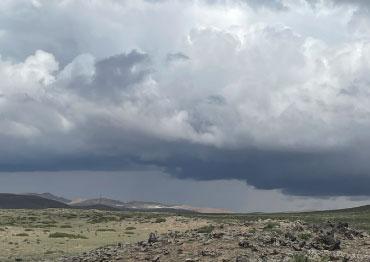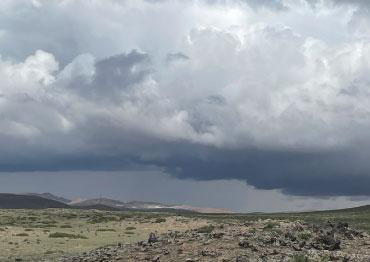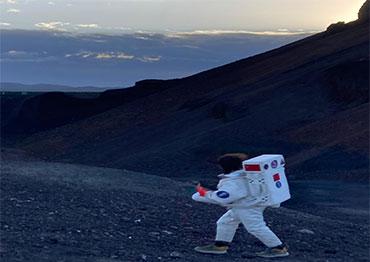If space-bro Elon Musk fails in his stated ambition to get to Mars, he could perhaps find an alternative in the otherworldly landscape of Ulanhada Volcano Geopark. They even provide the spacesuits. Or Harry Potter cloaks, though magic might not work as well as a rocket. They have those too, in the form of gigantic fireworks on sale to “recreate an eruption.”
The volcano park lies just inside the border of China’s Inner Mongolia Autonomous Region, in Charhar Right Rear Banner of Ulanqab, some 450 kilometers north of Beijing. This sticky summer, a trip to the cooler climbs of the Mongolian grasslands, where the eroded volcanic remnants stick up precipitously from the flat landscape, has been popular with families, as local authorities are eager to promote the area.
As a volcano nerd, I was keen to go – one problem, although getting to the nearest city of Ulanqab is easy by high-speed train from Beijing, it’s still 70 kilometers to the park, with no public transportation. Many people drive, hire a car in Ulanqab, or join a bus tour. My solution was to persuade a Chinese friend with a driving license to come, though I felt slightly guilty when we were faced with extra steps at the train station so I could register and pick up tickets, and when the first guest house said I couldn’t stay as police said no foreigners allowed. We found a newly opened resort, where the owner said on the down-low that because his place was new, he wasn’t connected to the registration system.
Much of the accommodation is dispersed in the grassland around the park, offering a choice of yurt-style or regular rooms. Food is fairly basic, but they all offer Mongolian lamb and mutton dishes. Vegetarians might want to bring their own food, as there are no shops or restaurants and the nearest town of Baiyinchagan is about 20 minutes’ drive. The place was quiet when we went, though the owner was ominously testing a karaoke system. He had invested some 8 million yuan (US$1.1m) in this and a nearby resort, he said, obviously expecting things to get much busier.
So far, the park is free to enter, a rarity in China. A road winds through the main volcanic cones, and you can stop where you like for photos or to walk around. The last burst of volcanic activity in the area was some 10,000 years ago, and the cones form the southern-most end of a chain of ancient volcanos that sweep to China’s northeast for some 1,000 kilometers.
There are eight main volcanos and peaks, all numbered, though they have fanciful Chinese names too. The most popular are No.3, where there is a wooden staircase to the summit, No.6, where there are off-road quad bikes for hire, as well as the astronaut costumes in a range of mostly pastel colors, and No.5, an almost perfect conical volcano with a sunken crater. No.4 volcano has a small museum.
We started at No.6 volcano, or South Alchemy Furnace. It has been extensively mined, leaving a deformed cone, half blasted away to reveal the red rocks and a distinct whiff of sulfur. This is the hot spot for “spacewalks”, as people descend to the base to pose among the barren rocks in their bulky space suits and wonky helmets. A crushed-rock path around the cone affords good views of the adjacent mountains.
Next stop was No.3, the place to view the sunset, we were assured. However, after slogging up the steps to the top, around 700 meters high, the wind became so strong we were almost blown off. Descending into the actual crater, a small tornado formed in the center. It’s also known as “Little Mount Fuji,” for its snow-covered winter slopes, a literal landscape of ice and fire, or even more grandly, the “Alchemy Furnace of the Lord Laozi,” the ancient Taoist philosopher who is credited with writing the Tao Te Ching.
The following day, after a karaoke-less night, we visited the park once more. At No.2 peak, or North Jianshan Mountain, tourists fossicked for rocks, until a rainstorm, accompanied by strong winds, sent people scurrying for cover. Together with its neighbor, South Jianshan Mountain, the two are poetically known as “Double Breasts Peaks.” Not volcanos, these landforms are tectonic formations. A path to the top brings panoramic views of Nos.5 and 6 cones, although on this occasion, the weather was a little too extreme to linger. It had been an usually dry year, the guesthouse owner had assured us, and the winds didn’t normally blow in summer. Certainly the skinny herds of sheep, goats and horses roaming around were evidence that the grass was not flourishing. A word of warning – although the high winds we experienced were unusual and provided a welcome break from the stifling heat of Beijing, I wished I’d brought walking poles, as the rocks are loose and slippy, and I abandoned my summit attempt with just a few meters to go out of safety concerns.
Driving back to Ulanqab, certainly the cleanest Chinese city I’ve ever seen, with its wide boulevards and enormous new civic buildings, we took the scenic route through the Huitengxile Grassland, famous for its Valley of the Flowers and extensive windfarms. I had looked at this as an alternative accommodation base, but many comments on guesthouse sites pointedly said that if you liked views of wind turbines more than grasslands, then this was for you. I do like wind turbines, but perhaps not in front of my window. The accommodation choices did not look as good as around the volcano, and the area as a whole was much more commercial, with many places offering activities like horseback riding and archery.
If you wanted to see the actual Valley of the Flowers, you must brave a one-way driving system with occasional traffic jams, navigate the huge welcome center (though it did have reasonable toilets and food options), dodge the crowds, and pay an entrance fee. We opted to drive around outside, where it was free. There are marked places to stop on the road, and as long as you are careful, you can walk among the flowers, which after the rain were blooming in sprigs of white, purple, yellow and blue.
After a rainy morning, the afternoon was marked by clear blue skies and rainbows. “It looks like the old Microsoft screensaver,” my friend remarked.
While pleasant to see the flowers and extensive grasslands, the commercialism is in stark contrast to the still-undeveloped volcano park. But more tourists, and the ubiquitous influencers, are certainly on their way, judging by the construction and road improvements, and possibly entrance gates. As Laozi almost probably didn’t say, “Go now, before the ravaging hordes descend.” Or Elon Musk.

 Old Version
Old Version

